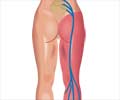An acute ankle and knee pain that refused to go for a decade, but was miraculously cured by non-invasive electromagnetic therapy, has prompted an NRI to bring the Scandinavian pain relief technique to India.
Sudhir Kashyap, a 62-year-old Sweden-based businessman, has brought to India the Pulsating Electro Magnetic Field (PEMF) therapy, which sends magnetic pulses through the blood veins and increases blood circulation to take away the pain.According to Kashyap, it is an "effective treatment of knee, ankle pain and osteoporosis treatment".
"I received the PEMF treatment in Sweden and was cured of the problem. Since I know India and the enormity of the problem, I brought the technique to Delhi," said Kashyap.
The businessman confessed he had been a chain smoker for over 35 years and the pain in his ankle and knee was due to smoking. When all other treatments failed, he decided to try PEMF. It took just 18 sittings over three months to get cured, said Kashyap.
"The PEMF therapy has received good response from several medical quarters and some are carrying out research on it. Escorts Hospital and Sports Medicine Department of Guru Nanak Dev University in Punjab have shown interest," he added.
Vikram Singh Yadav, sports medicine specialist at Guru Nanak Dev University, said that apart from pain relief, the technique was beneficial for treatment of osteoporosis as well.
Advertisement
"We send electromagnetic pulses through the veins which clears the blockages," Yadav told IANS.
Advertisement
Ashok Gupta, vascular surgeon at Escorts Hospital, said abnormal values of ABPI indicate insufficient blood flow that could cause slow degeneration of the tissues, ageing and disorders, or, in extreme cases, life threatening conditions such as gangrene leading to amputations.
Arguing in favour of ABPI, Gupta said: "Blood pressure is measured only on one arm. ABPI is computed by measuring blood pressure at the ankle and arm on both sides of the body."
"Blood pressure readings only indicate cardiac risk, but ABPI indicates blood flow disorders through the overall condition of arteries and veins of the limbs. It is a much more advanced technique for predicting and controlling diseases, disorders and degeneration," he added.
The therapy is available in a clinic that Kashyap has set up in south Delhi, called CirQcare. The cost of 12 sittings is around Rs.6,000.
According to Yadav, 15 sittings of 30 minutes each could relieve ankle injury up to 90 percent.
Ravi Sawhney, an advisor at Kashyap's CirQcare clinic, said they were organising camps to create awareness about the treatment. "Scores of people are visiting us for the therapy, but the word needs to be spread. We are now giving a free ABPI check up to tell patients about the benefit," he said.
Neena Paul, a patient at the clinic, said: "I have tried many treatments and therapies for my shoulder pain, but did not get much relief. I have taken 10 sittings of this therapy and am feeling much better."
Source-IANS
MED










